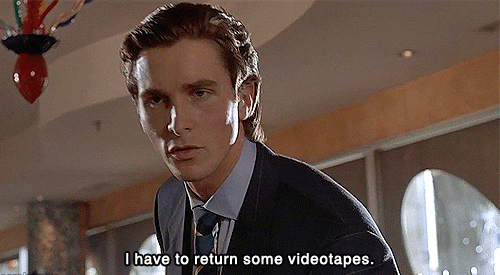An analysis of American Psycho, the book that it was adapted from, the controversy surrounding it, and the way in which it was adapted for screen. This discussion covers the claims of misogyny surrounding the original novel, and dissects how gender was then presented in the 2000 film. Contains spoilers for both the 1991 book and 2000 film. Originally written in June 2021.
Topics: Gender - Feminism - Male Gaze - Female Gaze - Book Vs Film - Controversial Media - Mary Harron - American Psycho

The 2000 film American Psycho is a piece that has been fraught with controversy since talks for the film began in 1992. The announcement of the film was met with immediate protest, particularly from feminist organisations who viewed the production as being intrinsically misogynistic. It is understandable then that the idea of such a story being brought to screen would have caused outcry, however the film that was eventually produced is contradictory to the initial fears about its nature.
American Psycho is about a Wealthy, yuppie businessman in the 1980s named Patrick Bateman, who leads a double life as a serial killer. The film focuses on Bateman’s daily rituals, material possessions and obsessive minutia of every aspect of his life, all to maintain his idea of ‘fitting in’. This is paired against scenes depicting Bateman’s life outside his sphere of associates in which he engages in violent activity with the same unvaried attitude as he does the rest of his life. The film itself is a satirical, black-comedy slasher, with much of the comedy coming from Bateman’s internal narration of the onscreen events.
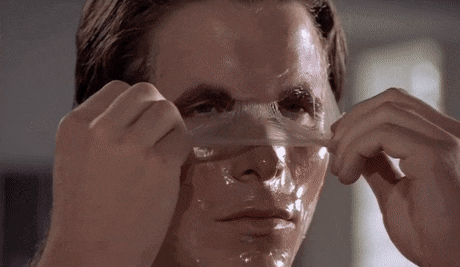
American Psycho is adapted from the 1991 novel of the same name by author Brett Easton Ellis, arguably one of the most polarising and controversial works of post-modern fiction. Ellis had trouble initially publishing the book, with his first publisher eventually withdrawing from the project. When the book was finally released Ellis received significant backlash. When the Los Angeles Times published a positive review of the book, “[The newspaper] had a three-page letters section of [numerous] people cancelling their subscriptions”. The graphic depictions of extreme violence against women and the protagonist's misogynistic views lead to the book being restricted and even banned in some countries, so concerning was its content viewed to be. The book was protested by the National Organisation for Women and vocally criticised by feminist activists, including Gloria Steinam. The book has even been reported on in reference to a serial murder trial, although its actual relevance to the case has been disputed and the novel was never referenced in the trial. The American Psycho novel maintains its controversial reputation to this day, despite Ellis’ affirmations that the book was intended to be satirical many still believe the book to be harmful and misogynistic.

To understand why American Psycho has been called misogynistic we must first understand what gender is from a cultural perspective. One way that gender can be analysed is as the state of being masculine or feminine and can be critically analysed in terms of sociological differences. There exist separate cultural ideas of what is traditionally considered masculine and what is traditionally considered feminine. For example, in Western culture traits traditionally viewed as masculine include strength, courage, independence, leadership and assertiveness, whilst culturally feminine traits include gracefulness, gentleness, empathy, humility and sensitivity.
Toxic masculinity is the normalisation of performances by men which harm society and men themselves. This can include self-destructive behaviour such as alcoholism, avoiding medical treatment and violent, criminal behaviour. Contrastingly, toxic feminity can be similarly defined with examples such as putting down other women in order to elevate oneself, and physical appearance self-harm such as eating disorders. Toxic masculinity has been described by sociologist Michael Flood as the “expectations that boys and men must be active, aggressive, tough, daring and dominant.” This concept of social adherence to only specific gender norms leads to increased incidences of depression and suicide in men and also violence and abuse towards women, including sexual assault and domestic violence. Toxic masculinity is ever-present in American Psycho, in both the story’s protagonist and the social circle with whom he spends his free time.
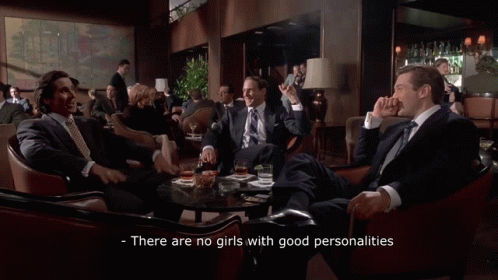
The fears surrounding a film adaptation of American Psycho centred on the idea that the medium would create a more personal connection to the main character, Patrick Bateman, glamorising the lifestyle and actions of an ultra-violent and hate-driven man. The novel is written in first person from Bateman’s perspective and the reader is personally subjected to his thoughts and actions. Bateman embodies the extreme aspects of toxic masculinity, namely extreme aggression and tendency towards violence, as well as a complete lack of feminine cultural ideas such as gentleness and empathy. It is entirely possible that American Psycho’s film adaptation could have been a movie that encouraged, (however unintentional) the idolisation of its protagonist, the same way that people feared about its source material. But the 2000 film ultimately does no such thing, in fact quite the opposite.
American Psycho was directed by Mary Harron who also adapted the screenplay with co-writer Guinevere Turner. Whilst one of American Psycho’s greatest strengths is its dedication to the source material, Harron and Turner made several distinct changes in their adaptation which differ the tone of the film from the novel. The author of the 1991 novel, Brett Easton Ellis has praised Harron's adaptation, but ultimately disavowed the film adaptation of his work, describing the novel as “unfilmable”. Ellis has affirmed numerous times his individual opinion that women are inherently bad directors because they lack the ‘male gaze’. He says of film, “I think it's a medium that really is built for the male gaze and for male sensibility. The best art is made not under an indifference to but a neutrality toward the kind of emotionalism that I think can be a trap for Women directors”.
In regard to the visual arts, the ‘male gaze’ is the act of depicting the world through a masculine, heterosexual perspective. The term ‘male gaze’ was first coined by film theorist Laura Mulvey who described the phenomena as “pleasure in looking” which has been split between active male and passive female. In particular, the theory emphasises the perception of women through this male gaze. This perspective can be further defined into individual ‘gazes’; that of the characters within the film, that of the filmmaker and that of the spectator. The first ‘gaze’ is represented by the way that the male characters in the film interact with the female ones. This is based in instances in which the female characters in a film are not present to impact the outcome of the plot or drive the story, but rather to visually support the male ones. The second ‘gaze’, that of the filmmaker is represented through the use of the camera, in the way that women are filmed, where the camera can be seen as an extension of the male eye. The final ‘gaze’, that of the spectator, is the way in which the audience viewing the film are encouraged by these gazes to view women from the same, objectifying perspective. Philosopher Mary Devereaux explained the theory, “In literal terms, the gaze is male when men do the looking. Men look both as spectators and as characters within works. In figurative terms, to say that the gaze is male refers to a way of seeing which takes women as its object. In this broad sense, the gaze is male whenever it directs itself at, and takes pleasure in, women, where women function as erotic objects.” In Ellis’ comment he is stating his belief that art made through the male gaze is intrinsically better because of it, and women, who do not often create through the male gaze, are less likely to create successful art for this reason. However, American Psycho is a prime example of just why this belief is so arguably incorrect.
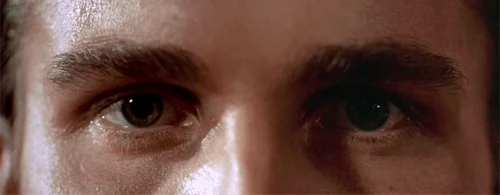
The real greatest strength of Mary Harron's American Psycho is its presentation through the female gaze. As with the male gaze, the female gaze can be viewed from the same three perspectives of subject, filmmaker and audience but this time with the perspective that the observer is female. The novel's prolonged and graphic depictions of violence are not enjoyable to read. The book presents sequences which are intended to be nauseating and upsetting, it is incredibly successful as a horror, but these sequences can be so intense that they pull focus from the story’s intended satire. In the book, Bateman's world is depicted as dull and grey, the only colour leaking through in the form of violence and murder. Despite the book's persistent usage of black comedy, the extent of the horror can sometimes be exhausting to read, to the point where a lot of what should be read as comedic falls flat. Whenever the audience is presented with violence in the film more focus is placed on the aftermath, not lingering on sequences to the point where the intent of a scene might be lost under the excess of gore. Harron was struck by the novel's extreme violence and made the decision that she wanted her version to place focus on the book's dark humour instead. Mary Harron's American Psycho tones down the violence and turns up the satire.
This is Harron’s female gaze in action, the murders and violence in the film are presented through the eyes of the women, creating a sense of sympathy towards them that simply is not present in the book. The film refuses to linger on the violence, maintaining a bizarrely light-hearted tone which bolsters the comedy, further emphasising the contrast. The feeling of American Psycho the film and American Psycho the book is completely different, despite the film’s close faithfulness to its source material. In the film we see Patrick Bateman through the eyes of the women he interacts with, he invites two prostitutes to his apartment then asks them, “Don’t you want to know what I do?” When the two flatly respond with a no, he subjects them to an outline of his career anyway. He then proceeds to discuss his personal interests in great detail including a lengthy analysis of musician Phil Collin’s solo career, all the while intercut with shots of the women’s bored, disinterested expressions. Harron portrays the entire sequence from the position of a female observer, Bateman’s vanity is clear, he is not interesting, and he cannot even captivate the attention of those who he is paying to keep him company- all things which Bateman himself cannot see. Despite being played by a conventionally attractive actor in Christian Bale, the film makes it very clear that nothing about Patrick Bateman is attractive.
Later on, in the film when things escalate and Bateman attempts to kill one of the women, referred to as ‘Christie’, we are presented the film’s most violent sequence from Christie’s perspective. The camera focuses on Christie as she notices that Bateman has turned violent with another woman. She then attempts to flee the apartment without attracting Bateman’s attention and the camera follows her as she tries to navigate the unfamiliar territory. We see her rising panic as she discovers dismembered women in the rooms of the apartment, intercut with point of view shots placing the audience directly in Christie’s place. The tension rises as the audience feels Christie’s desperation as she bangs on the doors of neighbouring apartments desperate for help, we now want Christie to survive, we feel the same panic that she feels, and we need to see her get away in order to relieve that tension. When Bateman finally catches up to her with a chainsaw, the sequence peaks with tense camerawork as Christie attempts to flee down a stairwell. She is killed when Bateman drops the chainsaw down the stairs. The moment happens offscreen and the camera is focused on Bateman’s sadistic reaction, not his point of view of the death. The final image of the sequence is Christie’s still body in complete silence, sealing in the horror of the situation by presenting the aftermath, not the action. In the novel, this entire sequence is presented from Bateman’s perspective, taking on the role of hunter and eventual killer. It is easy to see how different this scene could have been interpreted if it were directed through the male gaze. As with the sequences in the book, from Bateman’s perspective the audience is almost encouraged to root for him in this scenario. Harron subverts tropes of the horror genre, especially those of slashers, by showing the details which are usually left offscreen and leaving out the ones that are usually focused on. There is no prolonged shot of the chainsaw slicing open Christie’s body, no graphic display of her innards, just her killer’s reaction and then silence. What we do see are the visceral emotions that the victim goes through as she tries to escape. Harron’s female gaze resists the allure of Bateman’s character, never once shying away from portraying him for what he really is, a perspective that can only really be captured through the eyes of another person.
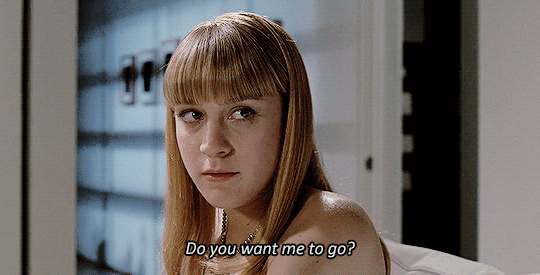
In many ways Mary Harron has succeeded in humanising one of the most inhuman characters in literature. This humanisation of extreme cases is not unusual for Harron, her very first film was I Shot Andy Warhol, a surprisingly sympathetic biopic about Valerie Solanas, the radical feminist who wrote the ‘SCUM’ manifesto and who attempted to murder artist Andy Warhol in 1968. Harron knows exactly which details of a character to focus on to make them seem like a real person, and the person who Patrick Bateman is, is a loser.
Harron described Bateman as a “buffoon” and stated, “the one thing you couldn't do was think that Bateman was in any way cool”. The film goes to great lengths to portray just how much of a loser Bateman really is, through the reactions of other characters towards him and Christian Bale’s exaggerated portrayal. One of the film’s stand-out scenes features Bateman profusely sweating and struggling to compose himself as he discovers that his work colleagues all have fractionally better business cards than him. In another scene he remarks that he is “almost on the verge of tears” when he arrives for dinner at a restaurant as he believes that he will not have a “good” table. Throughout the course of the film Bateman is constantly mistaken for other people who all lead almost identical public lifestyles. When Paul Allen mistakes Bateman for a co-worker, Bateman acknowledges that it would be an easy mistake to make as the two have the exact same job and dress in the exact same way, but he feels the need to add that “I have a slightly better haircut”. Both Patrick Bateman’s ridiculousness and complete lack of self-awareness are persistently re-affirmed in these little moments throughout the film. He is constantly being mocked, not just by his peer’s indifference towards him, but by his own words and actions. The great irony of the film is that Bateman is so mundane and so unnoticeable that he can go on a killing spree, and no one notices, cares or believes him. Bateman is obsessed with his own self-image, but to the rest of the world he is a faceless no one, echoing his own mental state and the main theme of the film: Inside doesn't matter.

American Psycho is about the kind of men who rely on trophy wives, positions and material goods to create the illusion of being interesting, as, without these things, these men are only empty shells of people without any sense of self. Bateman places more value and experiences more stress from having a good business card than he does from taking a human life. The Patrick Bateman of the film is pathetic and lost, not at all admirable. Guinevere Turner described the film as, “a satire about how men compete with each other and how in this hyper-real universe we created, women are even less important than your tan or your suit or where you summer”. American Psycho makes use of irony to subvert the audience’s expectations of the protagonist, adding layers to its source material by presenting a main character who is sympathetic but still unforgivable.
In his 2000 review of the film, Roger Ebert said, “it’s just as well a woman directed American Psycho. She's transformed a novel about bloodlust into a movie about men's vanity. A male director might have thought Patrick Bateman was a serial killer because of psychological twists but Mary Harron sees him as a guy who's prey to the usual male drives and compulsions. He just acts out a little more”. Whilst the 1991 novel continues to be the subject of controversy and criticism, its film adaptation has become a cult classic. Some even hail American Psycho as a feminist masterpiece, a title completely at odds with the reactions to its source material. Mary Harron and Guinevere Turner have created in American Psycho a subversive slasher that portrays a timeless message about shallow society, vanity and misogyny. It is Harron and Turner’s uniquely female gaze that transformed American Psycho from a grisly tale about relentless brutality into the black comedy satire that has become such a cult classic today.
